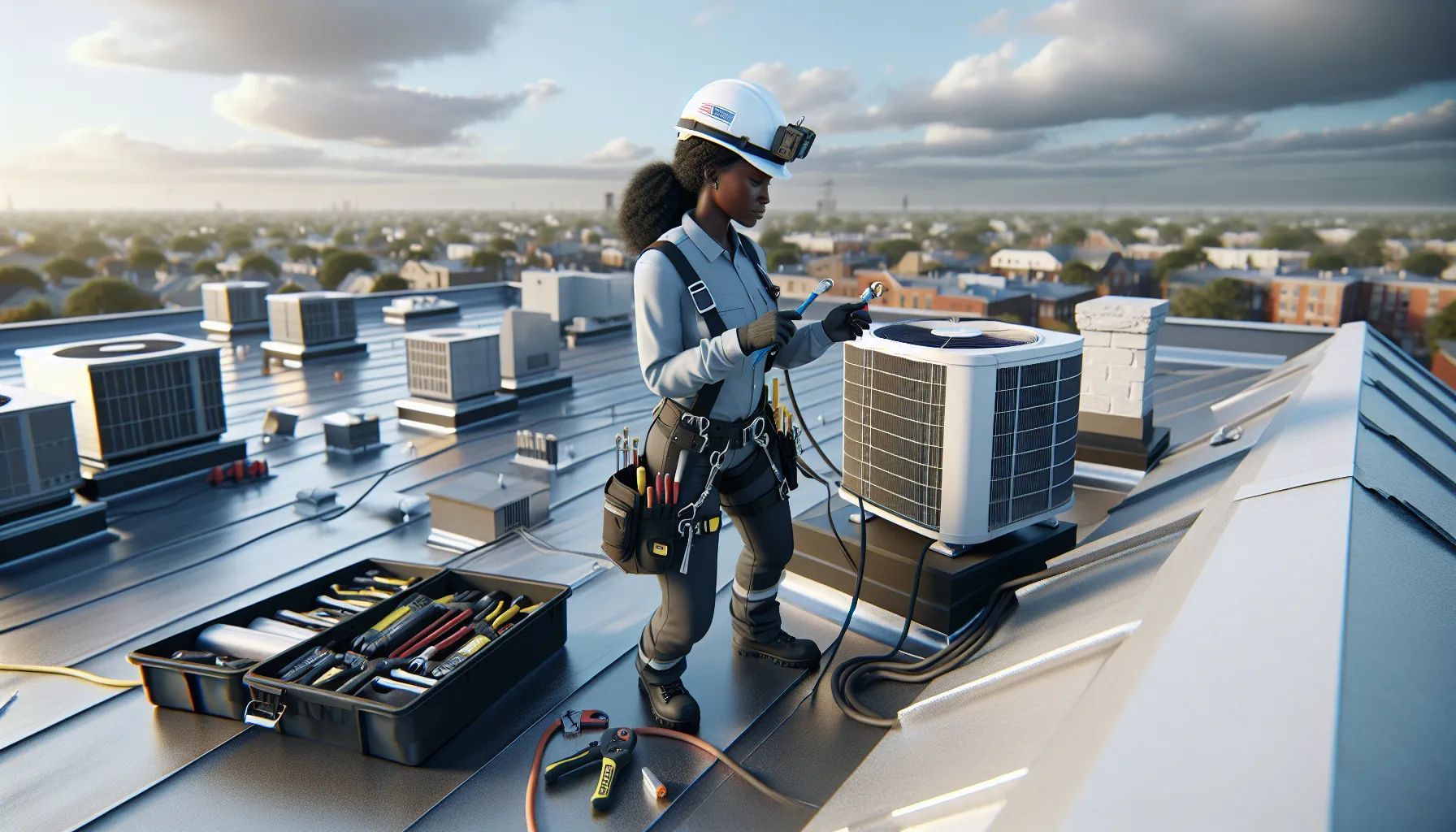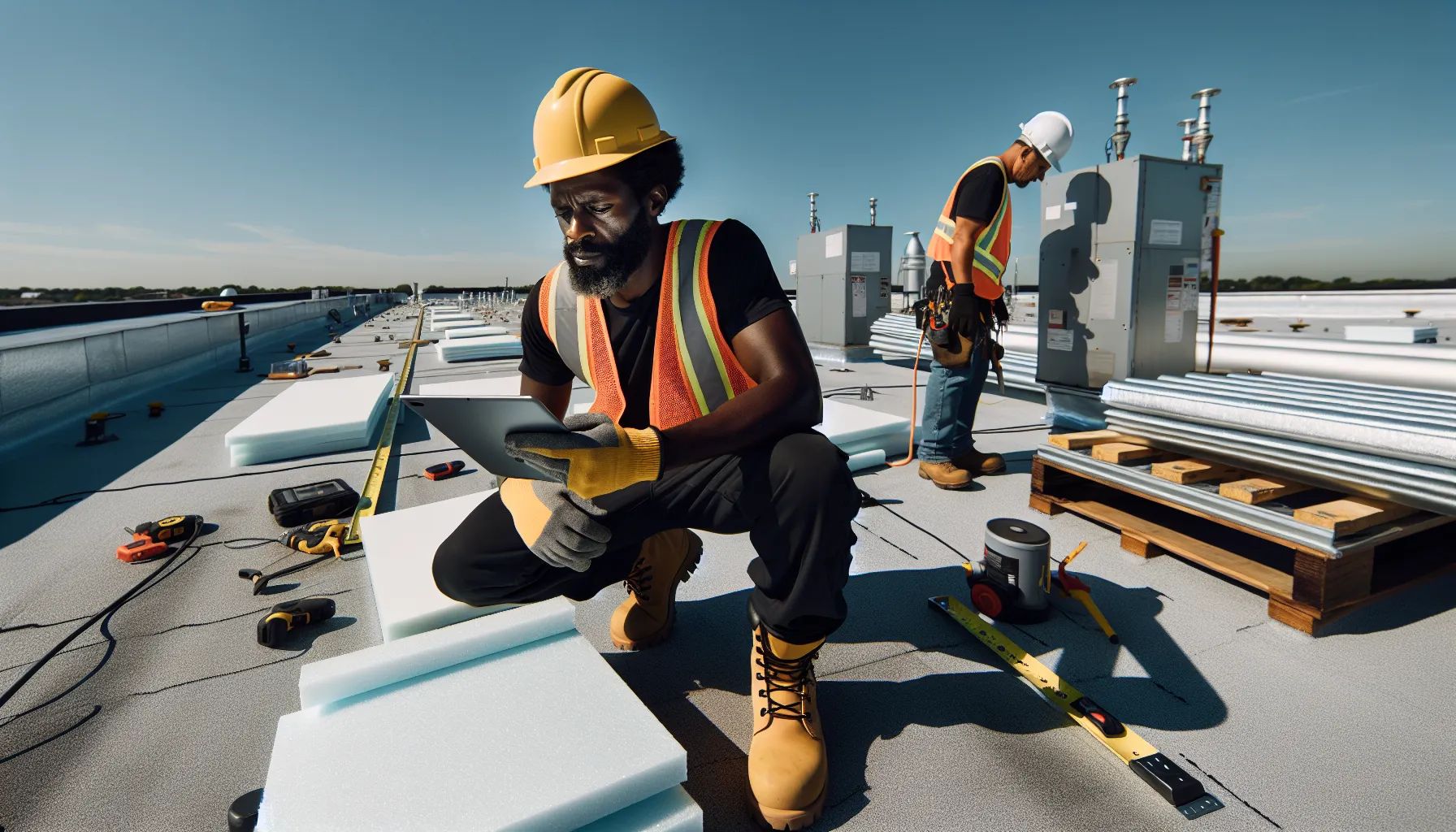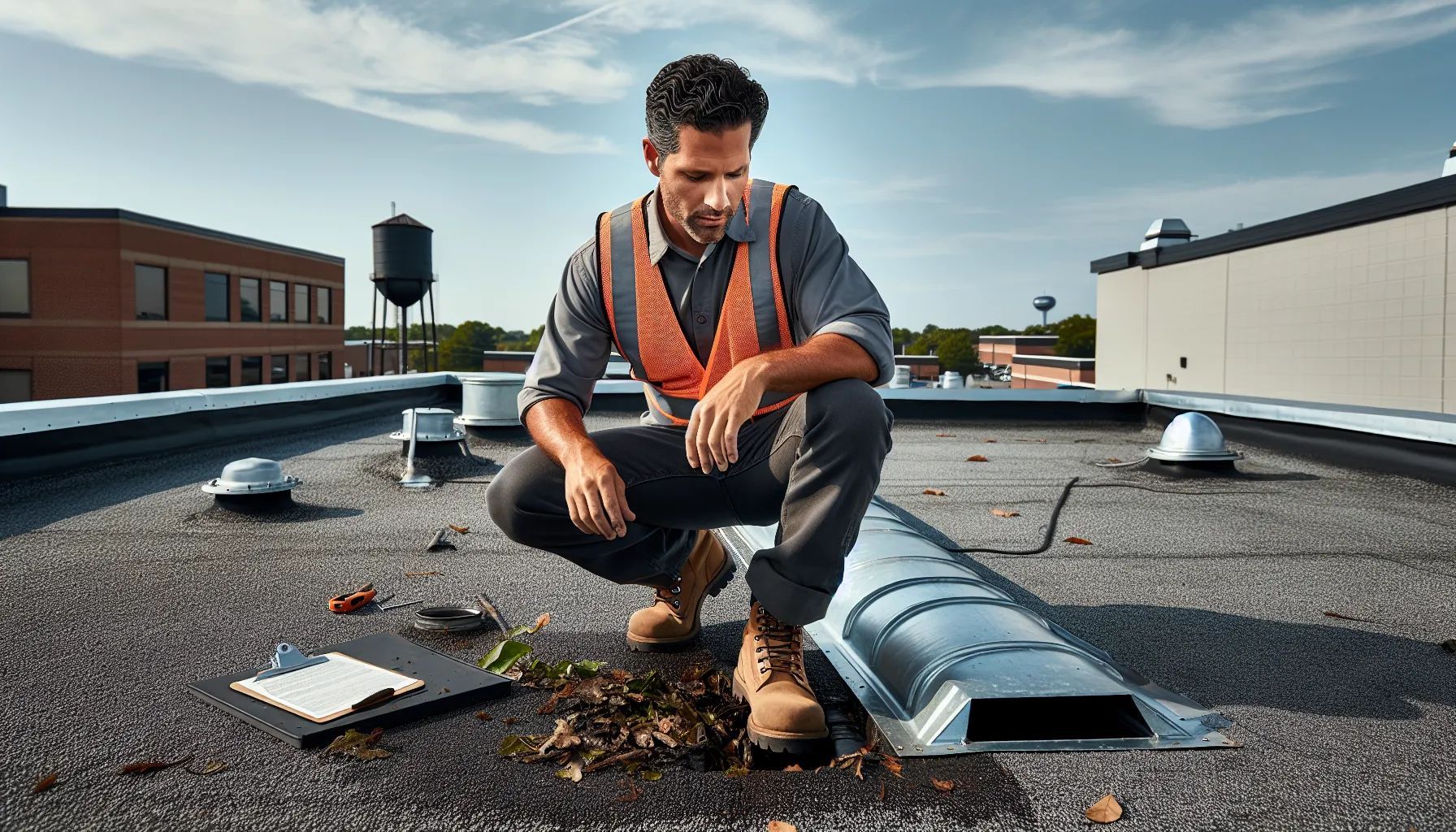Commercial Roof Preventative Maintenance Checklist: Essential Guide for Building Owners

A well-maintained commercial roof protects your business investment and prevents costly emergencies. We've seen firsthand how regular inspections and timely repairs can extend a roof's lifespan by decades while poorly maintained roofs fail prematurely.
Your commercial roof faces constant challenges from weather extremes and environmental factors. Without proper care it'll develop leaks damage your inventory and disrupt operations. That's why we've developed a comprehensive approach to roof maintenance that catches problems early.
The difference between reactive repairs and preventative maintenance can save thousands of dollars annually. We'll show you exactly what to look for and when to schedule inspections. By following our proven system you'll maximize your roof's performance and avoid unexpected failures.
Essential Components of a Commercial Roof Preventative Maintenance Checklist
A comprehensive commercial roof maintenance checklist covers critical components that protect your building from water damage and structural deterioration. We examine three fundamental areas that require regular attention to maintain optimal roof performance.
Drainage Systems and Gutters
Drainage systems remove water from your commercial roof within 48 hours after rainfall. We inspect drains, scuppers, and gutters monthly to prevent water accumulation that causes 40% of premature roof failures.
Check drain strainers for debris accumulation including leaves, dirt, and bird nests. Clear blockages immediately as standing water adds 5 pounds per square foot of weight to your roof structure. Examine downspouts for proper water flow by running water through each drain during dry conditions.
Inspect gutter connections at 10-foot intervals for separation or sagging. Replace damaged hangers and brackets that show rust or corrosion. Clean gutters twice yearly in spring and fall when trees shed leaves and seeds most heavily.
Document water pooling locations that persist 48 hours after rain. Mark these areas on your roof map for contractor evaluation. Install additional drains in zones where water pools exceed 1 inch in depth.
Flashing and Sealants
Flashing creates watertight barriers at roof penetrations and transitions where 90% of commercial roof leaks originate. We examine metal flashing monthly for rust, separation, or loose fasteners that compromise water protection.
Test sealant flexibility by pressing firmly with your thumb. Replace brittle or cracked sealants that fail this test. Apply new sealant when gaps exceed 1/8 inch between flashing and roof surfaces.
Inspect flashing at these critical locations: HVAC units, skylights, vents, and parapet walls. Document flashing conditions with photos showing measurement references for tracking deterioration over time.
Check counter-flashing embedded in walls for proper overlap of base flashing by 4 inches minimum. Seal mortar joints showing cracks or missing sections with polyurethane sealant rated for 20-year durability.
Review expansion joint covers every 6 months for torn fabric or separated metal plates. Replace covers showing holes or tears larger than 1 inch to prevent water infiltration into building joints.
Roofing Membrane Inspection Points
Commercial roofing membranes require systematic inspection across the entire surface to identify punctures, tears, and weathering. We divide the roof into 100-square-foot sections for thorough examination.
Look for membrane bubbles or blisters indicating moisture trapped beneath the surface. Measure and record blisters exceeding 6 inches in diameter for professional repair. Small blisters under 2 inches typically don't require immediate attention if the membrane remains intact.
Examine seams between membrane sheets for separation or fishmouthing where edges curl upward. Test seam integrity by gently pulling at 5-foot intervals. Mark failed seams that separate with minimal pressure for resealing.
Check membrane attachment at perimeter edges and penetrations. Count loose fasteners per 10-foot section and note areas with more than 2 missing or backing-out fasteners. Photograph UV damage appearing as surface cracking or chalking for comparison during future inspections.
Seasonal Maintenance Tasks for Commercial Roofs

Commercial roofs face unique challenges throughout the year as weather patterns shift from hot summers to freezing winters. We've developed specific seasonal maintenance tasks that protect your roof investment and prevent 75% of weather-related damage when performed consistently.
Spring and Summer Maintenance Activities
Spring maintenance starts with debris removal after winter storms. We remove accumulated leaves, branches and dirt that collected during colder months. These materials trap moisture against the roof surface and accelerate membrane deterioration.
Gutter cleaning takes priority during spring inspections. We clear all drainage channels before summer rainstorms arrive. Blocked gutters cause water to back up onto the roof deck and create ponding areas that damage membranes within 48 hours.
Surface inspections reveal winter damage patterns. We check for cracks in the membrane caused by freeze-thaw cycles. Blistering appears on 30% of commercial roofs after temperature fluctuations exceed 40 degrees between day and night.
Summer heat creates thermal expansion stress. We inspect all roof penetrations including HVAC units, vents and skylights for seal integrity. High temperatures cause sealants to soften and separate from flashing edges.
UV radiation degrades roofing materials fastest between June and August. We apply protective coatings to vulnerable areas and repair any surface crazing before it develops into full cracks.
Fall and Winter Preparation Steps
Fall preparation begins with comprehensive roof assessments. We complete detailed inspections before temperatures drop below 50°F when repair materials stop adhering properly. Early detection prevents 85% of winter emergency repairs.
Drainage system preparation prevents ice dam formation. We ensure all drains, scuppers and gutters flow freely before the first freeze. A single clogged drain causes ponding that turns into 500-pound ice blocks.
Flashing reinforcement protects vulnerable transition points. We reseal all roof penetrations and wall connections using cold-weather compatible materials. Winter wind-driven rain penetrates gaps as small as 1/8 inch.
Insulation evaluation reduces heating costs and prevents condensation damage. We verify R-values meet commercial standards and repair any compressed sections. Poor insulation causes ice formation on interior roof decks.
Snow load preparation includes marking drainage paths and equipment locations. We install snow guards near critical areas and verify structural capacity meets local building codes. Commercial roofs support 20-40 pounds per square foot depending on design specifications.
Creating Your Custom Commercial Roof Maintenance Schedule

Commercial roofs require maintenance schedules that match specific building needs and local climate conditions. We develop customized plans that address unique roof characteristics while meeting manufacturer warranty requirements.
Monthly Inspection Requirements
Monthly inspections form the foundation of commercial roof preventative maintenance. We recommend scheduling these inspections on the same day each month to establish consistency.
Visual inspections identify early warning signs of damage. We examine the entire roof surface for punctures, tears, and loose fasteners. Debris accumulation receives immediate attention since leaves and branches trap moisture against roofing materials.
Drainage systems demand monthly attention to prevent water-related failures. We clear gutters, downspouts, and scuppers of accumulated debris. Standing water gets documented and addressed within 48 hours to prevent membrane degradation.
Roof access points require verification during monthly walkthroughs. We check ladder attachment points, safety rails, and hatch mechanisms for secure operation. Documentation includes photographs of problem areas and completed repair logs.
Weather events trigger additional inspections outside the regular monthly schedule. We inspect roofs within 24 hours after storms producing winds exceeding 50 mph or hail larger than 0.75 inches in diameter.
Quarterly and Annual Tasks
Quarterly tasks expand beyond basic inspections to include preventive actions. We schedule these activities during moderate weather conditions for optimal working conditions and thorough assessments.
Debris removal becomes comprehensive during quarterly maintenance. We remove accumulated organic matter from roof valleys, behind HVAC units, and along parapet walls. Power washing eliminates algae and lichen growth that deteriorates roofing materials.
Sealant inspections occur quarterly to maintain watertight integrity. We test all penetration seals, pipe boots, and equipment curbs for flexibility and adhesion. Caulking gets replaced when cracks exceed 1/8 inch or material shows signs of brittleness.
Annual tasks involve professional contractors performing detailed assessments. We coordinate these inspections with roofing manufacturers to maintain warranty compliance. Infrared moisture scans detect hidden water infiltration within insulation layers.
Minor repairs get completed during annual maintenance visits. We replace damaged fasteners, patch small membrane tears, and recoat worn traffic areas. Cost-effective repairs during scheduled maintenance prevent emergency service calls averaging $2,500 per incident.
Common Commercial Roofing Issues to Monitor

Commercial roofs face constant exposure to weather elements and environmental factors that create specific vulnerabilities. We identify five critical areas that require regular monitoring to prevent failures and maintain roof integrity.
Signs of Water Damage and Leaks
Water damage appears in both interior and exterior locations of commercial buildings. Interior indicators include ceiling stains, mold growth, and visible drips during rainfall. We find 65% of commercial roof leaks start at penetration points around HVAC units and skylights.
Exterior warning signs demand immediate attention. Ponding water lasting more than 48 hours after rainfall indicates drainage problems. Dark spots on roof decking signal moisture infiltration that weakens structural support. Our inspections reveal damaged flashing accounts for 30% of water entry points.
Deteriorating sealants create pathways for water infiltration. Cracked caulking around roof edges allows moisture to penetrate beneath membrane layers. We check sealant flexibility monthly since UV exposure causes brittleness within 24 months.
Early detection prevents expensive repairs. Water damage spreads rapidly through insulation layers and damages electrical systems. We document all moisture indicators with photographs and measurements for tracking progression.
Structural Concerns and Safety Hazards
Structural integrity depends on proper load distribution across roof decking. We inspect for sagging areas that indicate weakened support beams or water-saturated insulation. Roof decks supporting HVAC equipment require reinforcement every 60 months.
Safety hazards multiply without proper maintenance. Loose equipment creates risks during high winds. Algae growth produces slippery surfaces that cause falls. We maintain clear pathways and secure all rooftop installations with appropriate fasteners.
Load calculations determine safe weight limits for equipment and snow accumulation. Commercial roofs support 20-40 pounds per square foot depending on construction type. We verify compliance with local building codes through annual structural assessments.
Regular inspections catch small issues before escalation. Split seams expand 2-3 inches monthly without repair. Buckling membranes indicate thermal movement that compromises waterproofing. We schedule professional evaluations twice yearly to maintain warranty coverage and prevent catastrophic failures.
Documentation and Record-Keeping Best Practices
We maintain comprehensive records of all roof inspections and maintenance activities to track performance and extend roof lifespan. Our documentation system captures every access event, repair action, and condition assessment throughout the year.
Essential Documentation Components
We track all roof access by recording dates, personnel names, specific areas visited, and reasons for each visit. This access log creates accountability and helps identify patterns in roof traffic that might contribute to wear.
We use a standardized scoring system to rate roof components as Good, Fair, or Bad during each inspection. This consistent approach allows us to monitor deterioration trends and prioritize maintenance actions effectively.
Our photo documentation captures images of damage, completed repairs, and areas requiring monitoring. We organize these photos by date and location for easy retrieval during insurance claims or warranty disputes.
Creating Your Maintenance Toolkit
We assemble a dedicated toolkit containing inspection checklists, writing materials, roof plans, cameras, flashlights, and tape measures. This toolkit ensures consistent data collection during every roof visit.
Our checklists include specific inspection points for each roof component, from drainage systems to HVAC penetrations. We update these checklists annually based on manufacturer recommendations and observed failure patterns.
We store digital copies of all documentation in cloud-based systems for immediate access by maintenance teams and facility managers. This centralized storage prevents data loss and enables real-time collaboration.
Inspection Frequency Guidelines
Bi-Annual Inspection Schedule
This is paragraph text. Click it or hit the Manage Text button to change the font, color, size, format, and more. To set up site-wide paragraph and title styles, go to Site Theme.
We conduct detailed inspections every spring and fall to address seasonal damage and prepare for upcoming weather challenges. Spring inspections focus on winter damage assessment, while fall inspections prepare roofs for snow loads and freezing conditions.
Our inspection teams follow predetermined routes across roof surfaces to ensure complete coverage. This systematic approach prevents overlooked areas and maintains inspection consistency across different team members.
Monthly Maintenance Tasks
We perform monthly visual inspections focusing on high-risk areas like drains, gutters, and equipment penetrations. These brief assessments catch developing issues before they escalate into costly repairs.
Our monthly tasks include debris removal from drainage systems and verification of proper water flow. We document any standing water lasting more than 48 hours after rainfall as this indicates drainage problems.
We check roof access points monthly to ensure ladders, hatches, and safety equipment remain secure and functional. This regular verification maintains safe working conditions for maintenance personnel.
Component-Specific Inspection Protocols
Surface Material Assessment
We inspect membrane surfaces for punctures, tears, blisters, and UV degradation during each visit. Our teams pay special attention to high-traffic areas near HVAC units where foot traffic causes accelerated wear.
We test membrane adhesion at seams and edges using appropriate pull tests recommended by manufacturers. Failed adhesion tests trigger immediate repair scheduling to prevent water infiltration.
Flashing and Penetration Points
We examine flashing around all roof penetrations including vents, skylights, pipes, and equipment supports. Our inspection focuses on seal integrity, metal corrosion, and proper water-shedding angles.
We document any separation between flashing and roof surfaces exceeding 1/16 inch as potential leak points. These measurements guide repair prioritization and material ordering for maintenance crews.
We verify that all penetration seals remain flexible and crack-free through physical manipulation tests. Hardened or brittle seals receive immediate replacement to maintain waterproof barriers.
Data Analysis and Trend Monitoring
Performance Metrics Tracking
We compile monthly data into quarterly performance reports showing repair frequencies, material costs, and labor hours by roof section. These metrics reveal problem areas requiring design modifications or increased maintenance attention.
Our analysis identifies seasonal patterns in repair needs, allowing proactive scheduling of maintenance resources. For example, we track sealant failures correlating with temperature extremes to optimize replacement timing.
We calculate cost-per-square-foot maintenance expenses annually to benchmark performance against industry standards. This financial tracking supports budget planning and replacement timing decisions.
Predictive Maintenance Planning
We use historical data to forecast component lifespans and schedule replacements before failures occur. Our predictive models consider weather exposure, foot traffic patterns, and manufacturer specifications.
We maintain replacement part inventories based on failure frequency data from our documentation system. This preparation reduces repair delays and minimizes business disruptions from roof issues.
We share trend reports with building owners quarterly to support capital planning decisions. These reports include projected maintenance costs and recommended improvement projects based on documented performance patterns.
Digital Documentation Systems
Cloud-Based Storage Solutions
We carry out secure cloud storage systems allowing instant access to roof documentation from any location. Our systems include automatic backup features protecting against data loss from hardware failures.
We organize files using standardized naming conventions incorporating dates, locations, and inspection types. This systematic approach enables quick document retrieval during emergencies or warranty claims.
We grant role-based access permissions ensuring maintenance teams, facility managers, and contractors view only relevant documentation. This security measure protects sensitive building information while facilitating necessary collaboration.
Mobile Inspection Applications
We use tablet-based inspection apps enabling real-time data entry directly from roof surfaces. These applications include dropdown menus, photo integration, and GPS location tagging for accurate record creation.
Our mobile systems sync automatically with central databases eliminating manual data transfer errors. This immediate synchronization ensures all team members access current information during decision-making.
We generate inspection reports directly from mobile devices, reducing administrative time and accelerating repair scheduling. These digital reports include annotated photos, measurements, and recommended actions for each identified issue.
Compliance and Warranty Requirements
Manufacturer Documentation Standards
We follow specific documentation requirements outlined in roofing manufacturer warranties to maintain coverage validity. Our records include installation dates, material specifications, and all maintenance activities performed.
We submit annual inspection reports to warranty providers demonstrating compliance with maintenance requirements. These submissions protect warranty coverage and document proper roof care for potential claims.
We maintain original installation documentation including contractor certifications, material test reports, and inspection certificates. This comprehensive record supports warranty claims and proves proper installation procedures.
Building Code Compliance Records
We document all structural modifications, equipment additions, and load calculations affecting roof capacity. These records demonstrate ongoing compliance with local building codes during inspections.
We track snow load measurements during winter months comparing actual loads against design specifications. This monitoring ensures roof structures operate within safe parameters throughout severe weather events.
We file all required permits and inspection reports with local authorities maintaining proof of regulatory compliance. This documentation prevents code violations and supports insurance claims after weather-related damage.
Communication and Reporting Protocols
Stakeholder Communication Systems
We establish clear communication channels connecting maintenance teams, facility managers, and building owners through our documentation platform. Regular updates keep all parties informed about roof conditions and maintenance activities.
We generate monthly summary reports highlighting completed tasks, identified issues, and upcoming maintenance requirements. These concise reports enable quick decision-making without overwhelming recipients with technical details.
We create emergency contact lists within our documentation system ensuring rapid response capability during roof failures. These lists include contractor information, material suppliers, and key decision-makers for each building.
Working with Professional Roofing Contractors
Professional roofing contractors bring specialized expertise and advanced diagnostic equipment that enhance commercial roof preventative maintenance programs. We recognize that certified professionals identify hidden problems early and provide comprehensive solutions that extend roof lifespan while maintaining warranty compliance.
When to Call for Expert Assessment
We recommend contacting professional roofing contractors when inspection ratings indicate "bad" conditions requiring immediate attention. Structural damage signs like deck rot, membrane tears, and flashing splits demand expert evaluation within 48 hours to prevent further deterioration.
Professional assessment becomes critical after severe weather events including hailstorms, hurricanes, or wind speeds exceeding 60 mph. Certified contractors use infrared cameras and moisture meters to detect water infiltration that visual inspections miss.
Ponding water lasting over 48 hours signals drainage failures that professionals address through comprehensive system evaluations. Dark stains, discoloration patterns, or visible mold growth require immediate expert intervention to prevent structural damage.
Annual professional inspections maintain manufacturer warranty validity and ensure compliance with commercial building codes. We schedule these assessments during spring months when contractors can address winter damage before summer heat accelerates deterioration.
Complex roof systems with multiple penetrations, HVAC units, or skylights benefit from quarterly professional evaluations. Certified inspectors document all findings using standardized reporting systems that track component conditions over time.
Selecting the Right Maintenance Partner
We evaluate potential roofing partners based on specific certifications matching our roof type and manufacturer requirements. GAF Master Elite, Firestone Red Shield, and Carlisle Perfection Award contractors demonstrate proven expertise through rigorous certification processes.
Experience with similar commercial properties ensures contractors understand unique maintenance challenges. We verify contractors have completed projects on buildings with comparable square footage, roof systems, and operational requirements within the past 3 years.
Advanced diagnostic capabilities distinguish quality maintenance partners from basic service providers. Professional contractors use thermal imaging, electronic leak detection, and core sampling to provide accurate condition assessments beyond surface-level observations.
Comprehensive reporting systems track maintenance history and predict future repair needs through data analysis. We require detailed inspection reports including photo documentation, component ratings, and prioritized repair recommendations with cost estimates.
Emergency response capabilities protect our investment during unexpected failures. Quality maintenance partners guarantee 24-hour response times and maintain dedicated commercial service teams equipped for rapid deployment.
Insurance coverage including general liability minimums of $2 million and workers' compensation protects both parties during maintenance activities. We verify current certificates before authorizing roof access.
Conclusion
We've seen how a well-structured preventative maintenance checklist transforms commercial roofs from ticking time bombs into reliable assets that protect your business for decades. Your roof works hard every day defending against weather extremes and environmental challenges – it deserves the same level of attention you'd give any critical business system.
The path forward is clear: carry out monthly inspections paired with seasonal maintenance tasks while partnering with certified professionals who understand your roof's unique needs. Whether you're managing a single building or an entire portfolio the principles remain the same – consistent documentation systematic inspections and proactive repairs save money and prevent disruptions.
Take the first step today by downloading our maintenance checklist template and scheduling your initial roof assessment. Your future self will thank you when you're avoiding emergency repairs while competitors scramble to fix preventable failures. Remember that every dollar invested in preventative maintenance returns multiple times over through extended roof life and uninterrupted business operations.
What is commercial roof preventative maintenance?
Commercial roof preventative maintenance is a proactive approach to caring for your business's roofing system through regular inspections, timely repairs, and scheduled upkeep. This strategy identifies potential problems early before they become costly emergencies. It includes monthly inspections, seasonal maintenance tasks, and professional assessments to ensure optimal roof performance and extend its lifespan while protecting your investment.
How often should I inspect my commercial roof?
Monthly inspections are essential for commercial roofs, with additional checks after severe weather events. The maintenance schedule should include quarterly comprehensive assessments and annual professional evaluations. Monthly inspections focus on drainage systems, debris removal, and visible damage, while quarterly and annual reviews involve more detailed examinations of sealants, flashing, and structural components to maintain warranty compliance.
What are the most common commercial roofing problems?
The most common issues include water damage and leaks, particularly at penetration points around HVAC units and skylights (affecting 65% of commercial roofs). Other frequent problems are ponding water, deteriorating sealants, damaged flashing, and membrane punctures or tears. Structural concerns like improper load distribution and safety hazards from loose equipment also require regular monitoring to prevent failures.
How can I prevent water damage on my commercial roof?
Prevent water damage by maintaining clear drainage systems through monthly cleaning, as clogged drains cause 40% of premature roof failures. Regularly inspect and repair flashing and sealants around penetrations. Address ponding water within 48 hours and ensure proper roof slope. Schedule professional inspections to identify hidden moisture infiltration and maintain protective coatings to prevent membrane degradation.
When should I contact a professional roofing contractor?
Contact a professional contractor when inspections reveal deteriorating conditions, after severe weather events, or for annual compliance assessments. Also seek professional help for warranty-required inspections, when you discover structural concerns, or if water infiltration is suspected. Professionals have advanced diagnostic tools and expertise to identify hidden problems that regular inspections might miss.
What documentation should I keep for roof maintenance?
Maintain comprehensive records including inspection logs with dates and findings, photo documentation of damage and repairs, maintenance activity reports, and warranty information. Use a standardized scoring system for roof components and track performance metrics. Digital documentation systems with cloud storage ensure easy access and help with warranty claims, insurance purposes, and tracking maintenance trends over time.

